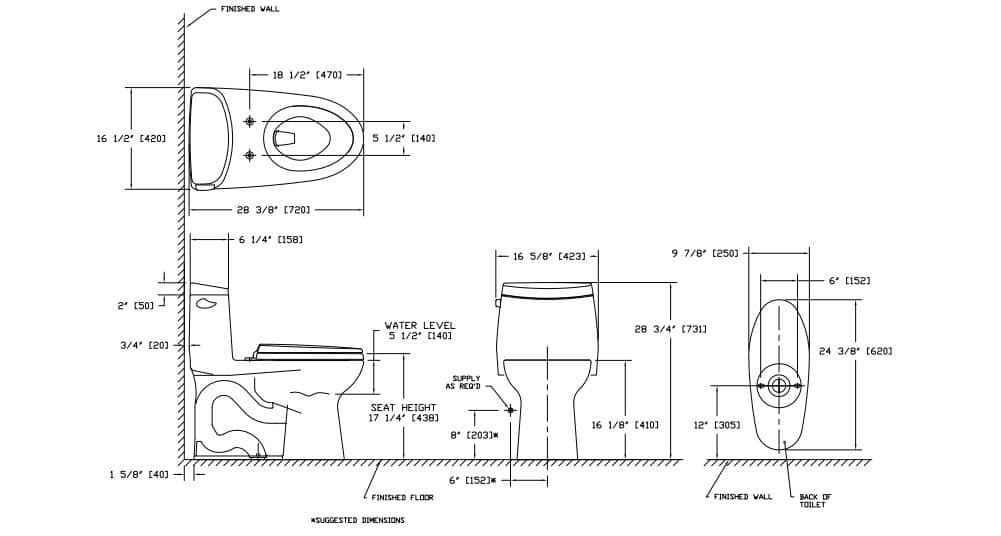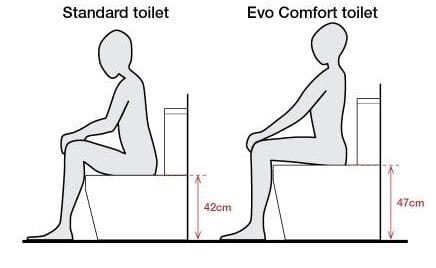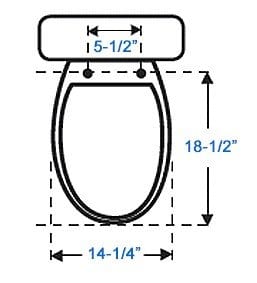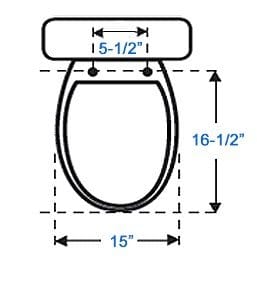Toilet Dimensions and Clearances You Must Know
Last Updated on July 18, 2023 by toilethaven
What are the Dimensions of a Standard Toilet?
Before buying a toilet, there are some important dimensions that you will need to determine in advance lest you end up with a toilet you cannot install or serve you as you would have wished.
The best way to know a toilet’s dimensions is by searching its name and model number on the manufacturer’s website. Once there, look for the specification sheet and go through the model drawings.
Toilet dimensions are especially important if you have a small bathroom. In that case, you would need to buy a small/compact toilet.
The dimensions of a standard toilet are 27 to 30 inches in depth, 27 to 32 inches in height, a width of 20 inches, and a rough-in of 12 inches. Chair-height toilets have a higher seat height than standard toilets, while elongated toilets have longer bowls than round toilets.
Toilet Dimensions

Toilet Rough-In
The rough-in of a toilet is the distance between the rear finished wall of the toilet and the center of the drainpipe. You must always ensure that you measure from the finished wall and not the baseboard.
When you measure the rough-in from the baseboard, your final measurement will be less by ½ inch, while if you measure from the unfinished wall, the measurement will be more by another ½ inch.
If your toilet is already installed, you can measure the rough-in from the rear finished wall to one of the 2 toilet bolts which anchor it on the floor. Please note that sometimes these bolts are covered with plastic caps.
The standard rough-in of most modern toilets is 12 inches. Some other toilets have a rough-in of 10 or 14 inches. This is especially so in old houses.
You can replace a toilet with another of the same rough-in or smaller rough-in but never a bigger rough-in. For example, you can replace a 14-inch rough-in toilet with another one with a 14-inch rough or 12-inch rough-in, but you cannot replace a toilet with a rough-in of 12 with another one with a rough-in of 14 inches.
The above method is used to measure rough-in in standard toilets, which are toilets that are installed flush of the bathroom wall. How do you measure the rough-in of a corner toilet or a rear outlet toilet?
A corner toilet is installed in the bathroom corner to conserve space. To determine the rough-in of a corner toilet, measure the distance between any of the two finished walls and the center of the toilet’s drainpipe.
To determine the rough-in of a rear outlet/discharge toilet, measure the distance between the finished floor and the center of the toilet outlet.
Toilet Bowl Height
The toilet bowl height is the distance between the toilet’s base and the top of the toilet rim. There are two types of toilet bowl heights, the standard bowl height and the comfort bowl height.
Standard-height toilets have a toilet bowl height of about 15 inches. They are a great choice for people who are short and young.
Comfort height toilets which are also called ADA-compliant/universal/right/chair height toilets, have a toilet bowl height of 17 to 19 inches. They are an excellent choice for seniors, tall, and all people with limited mobility.

Toilets installed in public bathrooms must have a comfortable height toilet bowl. The Americans with Disabilities Act (ADA) was enacted to safeguard the interests of Americans living with disabilities while using public toilets. The comfort height toilets are at the same height as a wheelchair seat; hence they are more comfortable to use.
If you have a standard-height toilet that you would like to transform into a comfortable-height toilet, you should use toilet seat risers which are also called raised toilet seats. Toilet seat raisers have a height of 2 to 7 inches.
A toilet seat riser can be a simple portable one, a toilet seat riser with arms, or a toilet seat riser with a safety frame. These seats are handy, especially when someone is recovering from knee or hip surgery.
Toilet Bowl Shape
Toilet bowls come in two shapes: round and elongated. Round toilet bowls are circular in shape, while elongated bowls are oval-shaped.
To determine the length of the toilet bowl, measure the distance between the center of the toilet seat mounting holes and the front of the toilet bowl. To do this, the toilet seat must have been removed.

Elongated toilet bowls have a length of around 18.5 inches, while round toilet bowls have a length of about 16.5 inches. Round toilets are, therefore, more space-economic but less comfortable than elongated toilets, which take up more space.
Compact elongated toilets, however, take the same size of space as round toilets while maintaining the comfort of elongated toilets.
I have written a detailed guide on elongated vs. round toilet bowls. Read it here.
Another important dimension is the bolt spread. This is the distance between the 2 toilet seat mounting bolt holes on the toilet bowl. In the US, toilets have a standard bolt spread of 5.5 inches, while in Europe, it can reach 6.5 inches.
Toilet bowls have a width of between 14 and 15 inches.
Toilet Height
Toilet height is the distance between the toilet’s base and the top of the toilet tank. Most toilets rarely exceed a height of 32 inches. It is important to determine the total assembled height of a toilet prior to buying one, especially if you have an over-the-toilet storage facility that you need the toilet to fit under.
Again the best way to know this is by obtaining the toilet drawings. Most of the dimensions available online can be misleading because they give the shipping dimensions instead of the assembled toilet dimensions.
Toilet Depth
The depth of a toilet is the distance from the back of the toilet to the front of the toilet rim. It is a very important toilet dimension, especially in a small bathroom where every inch counts.
Due to the shape of a toilet, it is not always easy to measure its depth, and if you are looking to buy a certain toilet, the best thing to do is to search for it on the manufacturer’s website and check its drawings which always have the dimensions.
Toilet Width
The toilet width is the measurement of the widest part of a toilet, normally the toilet tank. One mistake most people make is not including the measurement of the flushing handle.
As you will notice, the toilet’s flushing handle extends from the side of the toilet tank and will therefore need to be accounted for. Some manufacturers, however, install the toilet handle on the front side of the toilet, which saves up a few inches of space.
Toilet Clearance
Most building codes require that:
- A toilet should have at least a 24 inches clearance in front of it.
- Sidewalls or any other obstruction must be 15 or more inches from the toilet’s centerline.
- Any other sanitary fixture should be 30 inches or more from the toilet’s drain.
Toilet Seat Dimensions
Toilet seats, just like toilet bowls, are either round or elongated. An elongated bowl will need an elongated toilet seat, while round toilet bowls will need round toilet bowls.

To measure a toilet seat, you will need to measure the toilet bowl where the seat will be installed on.
Public Toilet Dimensions
Unlike private bathrooms, which you can design and remodel as you wish, private restroom dimensions are regulated by law. This occurred after the Americans with Disabilities Act (ADA) was passed. Although all public restrooms do not fully comply with ADA, this is the recommended dimensions:
- The sink should have a knee clearance of 27 inches, be 30 inches wide, 11-25 inches deep, and more than 34 inches high.
- The sidewalls of the cubicle should be between 16 to 18 inches from the center line of the toilet.
- The toilet should have a comfortable height of between 17 to 19 inches (seat height)
- Grab bars on the rear wall should be 36 inches long, while those on the sidewall wall should be 42 inches and mounted 33-36 inches above the floor.
- Enough space for a wheelchair to turn – A radius of 30 inches from the sidewall and 28 inches from the rear wall.